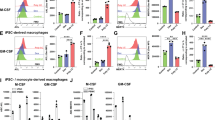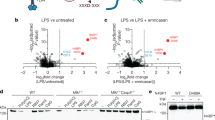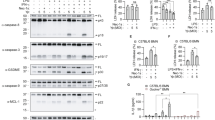Abstract
DAP12 is a signaling adaptor containing an immunoreceptor tyrosine-based activation motif (ITAM) that pairs with receptors on myeloid cells and natural killer cells. We examine here the responses of mice lacking DAP12 to stimulation through Toll-like receptors (TLRs). Unexpectedly, DAP12-deficient macrophages produced higher concentrations of inflammatory cytokines in response to a variety of pathogenic stimuli. Additionally, macrophages deficient in spleen tyrosine kinase (Syk), which signals downstream of DAP12, showed a phenotype identical to that of DAP12-deficient macrophages. DAP12-deficient mice were more susceptible to endotoxic shock and had enhanced resistance to infection by the intracellular bacterium Listeria monocytogenes. These data suggest that one or more DAP12-pairing receptors negatively regulate signaling through TLRs.
This is a preview of subscription content, access via your institution
Access options
Subscribe to this journal
Receive 12 print issues and online access
$209.00 per year
only $17.42 per issue
Buy this article
- Purchase on SpringerLink
- Instant access to full article PDF
Prices may be subject to local taxes which are calculated during checkout








Similar content being viewed by others
Change history
16 January 2009
NOTE: In the version of this article initially published, the dose of D-galactosamine for the endotoxic shock experiments described in the Methods section (20 μg) was incorrect. The correct dose is 20 mg. The error has been corrected in the HTML and PDF versions of the article.
References
Akira, S. & Takeda, K. Toll-like receptor signalling. Nat. Rev. Immunol. 4, 499–511 (2004).
Lanier, L.L. & Bakker, A.B. The ITAM-bearing transmembrane adaptor DAP12 in lymphoid and myeloid cell function. Immunol. Today 21, 611–614 (2000).
Bouchon, A., Dietrich, J. & Colonna, M. Cutting edge: inflammatory responses can Be triggered by TREM-1, a novel receptor expressed on neutrophils and monocytes. J. Immunol. 164, 4991–4995 (2000).
Bouchon, A., Facchetti, F., Weigand, M.A. & Colonna, M. TREM-1 amplifies inflammation and is a crucial mediator of septic shock. Nature 410, 1103–1107 (2001).
Daws, M.R., Lanier, L.L., Seaman, W.E. & Ryan, J.C. Cloning and characterization of a novel mouse myeloid DAP12-associated receptor family. Eur. J. Immunol. 31, 783–791 (2001).
Chung, D.H., Seaman, W.E. & Daws, M.R. Characterization of TREM-3, an activating receptor on mouse macrophages: definition of a family of single Ig domain receptors on mouse chromosome 17. Eur. J. Immunol. 32, 59–66 (2002).
Yotsumoto, K. et al. Paired activating and inhibitory immunoglobulin-like receptors, MAIR-I and MAIR-II, regulate mast cell and macrophage activation. J. Exp. Med. 198, 223–233 (2003).
Wright, G.J. et al. Characterization of the CD200 receptor family in mice and humans and their interactions with CD200. J. Immunol. 171, 3034–3046 (2003).
Dietrich, J., Cella, M., Seiffert, M., Buhring, H.J. & Colonna, M. Cutting edge: signal-regulatory protein β1 is a DAP12-associated activating receptor expressed in myeloid cells. J. Immunol. 164, 9–12 (2000).
Tomasello, E. et al. Association of signal-regulatory proteins β with KARAP/DAP-12. Eur. J. Immunol. 30, 2147–2156 (2000).
Shiratori, I., Ogasawara, K., Saito, T., Lanier, L.L. & Arase, H. Activation of natural killer cells and dendritic cells upon recognition of a novel CD99-like ligand by paired immunoglobulin-like type 2 receptor. J. Exp. Med. 199, 525–533 (2004).
Bakker, A.B., Baker, E., Sutherland, G.R., Phillips, J.H. & Lanier, L.L. Myeloid DAP12-associating lectin (MDL)-1 is a cell surface receptor involved in the activation of myeloid cells. Proc. Natl. Acad. Sci. USA 96, 9792–9796 (1999).
Diefenbach, A. et al. Selective associations with signaling proteins determine stimulatory versus costimulatory activity of NKG2D. Nat. Immunol. 3, 1142–1149 (2002).
Gilfillan, S., Ho, E.L., Cella, M., Yokoyama, W.M. & Colonna, M. NKG2D recruits two distinct adapters to trigger NK cell activation and costimulation. Nat. Immunol. 3, 1150–1155 (2002).
Bakker, A.B. et al. DAP12-deficient mice fail to develop autoimmunity due to impaired antigen priming. Immunity 13, 345–353 (2000).
Tomasello, E. et al. Combined natural killer cell and dendritic cell functional deficiency in KARAP/DAP12 loss-of-function mutant mice. Immunity 13, 355–364 (2000).
Colonna, M. & Facchetti, F. TREM-1 (triggering receptor expressed on myeloid cells): a new player in acute inflammatory responses. J. Infect. Dis. 187 (suppl. 2), S397–S401 (2003).
Turner, M., Schweighoffer, E., Colucci, F., Di Santo, J.P. & Tybulewicz, V.L. Tyrosine kinase SYK: essential functions for immunoreceptor signalling. Immunol. Today 21, 148–154 (2000).
Daws, M.R. et al. Pattern recognition by TREM-2: binding of anionic ligands. J. Immunol. 171, 594–599 (2003).
Bleharski, J.R. et al. A role for triggering receptor expressed on myeloid cells-1 in host defense during the early-induced and adaptive phases of the immune response. J. Immunol. 170, 3812–3818 (2003).
Radsak, M.P., Salih, H.R., Rammensee, H.G. & Schild, H. Triggering receptor expressed on myeloid cells-1 in neutrophil inflammatory responses: differential regulation of activation and survival. J. Immunol. 172, 4956–4963 (2004).
Mocsai, A. et al. The immunomodulatory adapter proteins DAP12 and Fc receptor γ-chain (FcRγ) regulate development of functional osteoclasts through the Syk tyrosine kinase. Proc. Natl. Acad. Sci. USA 101, 6158–6163 (2004).
Turner, M. et al. Perinatal lethality and blocked B-cell development in mice lacking the tyrosine kinase Syk. Nature 378, 298–302 (1995).
Mocsai, A., Zhou, M., Meng, F., Tybulewicz, V.L. & Lowell, C.A. Syk is required for integrin signaling in neutrophils. Immunity 16, 547–558 (2002).
Pasparakis, M., Alexopoulou, L., Episkopou, V. & Kollias, G. Immune and inflammatory responses in TNF α-deficient mice: a critical requirement for TNF α in the formation of primary B cell follicles, follicular dendritic cell networks and germinal centers, and in the maturation of the humoral immune response. J. Exp. Med. 184, 1397–1411 (1996).
Pamer, E.G. Immune responses to Listeria monocytogenes. Nat. Rev. Immunol. 4, 812–823 (2004).
Starr, T.K., Jameson, S.C. & Hogquist, K.A. Positive and negative selection of T cells. Annu. Rev. Immunol. 21, 139–176 (2003).
Pasquier, B. et al. Identification of FcαRI as an inhibitory receptor that controls inflammation: dual role of FcRγ ITAM. Immunity 22, 31–42 (2005).
Takahashi, K., Rochford, C.D. & Neumann, H. Clearance of apoptotic neurons without inflammation by microglial triggering receptor expressed on myeloid cells-2. J. Exp. Med. 201, 647–657 (2005).
Paloneva, J. et al. CNS manifestations of Nasu-Hakola disease: a frontal dementia with bone cysts. Neurology 56, 1552–1558 (2001).
Gibot, S. et al. A soluble form of the triggering receptor expressed on myeloid cells-1 modulates the inflammatory response in murine sepsis. J. Exp. Med. 200, 1419–1426 (2004).
Knapp, S. et al. Cutting edge: expression patterns of surface and soluble triggering receptor expressed on myeloid cells-1 in human endotoxemia. J. Immunol. 173, 7131–7134 (2004).
Lanier, L.L. Face off—the interplay between activating and inhibitory immune receptors. Curr. Opin. Immunol. 13, 326–331 (2001).
Brint, E.K. et al. ST2 is an inhibitor of interleukin 1 receptor and Toll-like receptor 4 signaling and maintains endotoxin tolerance. Nat. Immunol. 5, 373–379 (2004).
Diehl, G.E. et al. TRAIL-R as a negative regulator of innate immune cell responses. Immunity 21, 877–889 (2004).
Kinjyo, I. et al. SOCS1/JAB is a negative regulator of LPS-induced macrophage activation. Immunity 17, 583–591 (2002).
Nakagawa, R. et al. SOCS-1 participates in negative regulation of LPS responses. Immunity 17, 677–687 (2002).
Fukao, T. et al. PI3K-mediated negative feedback regulation of IL-12 production in DCs. Nat. Immunol. 3, 875–881 (2002).
Burns, K. et al. Inhibition of interleukin 1 receptor/Toll-like receptor signaling through the alternatively spliced, short form of MyD88 is due to its failure to recruit IRAK-4. J. Exp. Med. 197, 263–268 (2003).
Sly, L.M., Rauh, M.J., Kalesnikoff, J., Song, C.H. & Krystal, G. LPS-induced upregulation of SHIP is essential for endotoxin tolerance. Immunity 21, 227–239 (2004).
Zhang, G. & Ghosh, S. Negative regulation of toll-like receptor-mediated signaling by Tollip. J. Biol. Chem. 277, 7059–7065 (2002).
Chuang, T.H. & Ulevitch, R.J. Triad3A, an E3 ubiquitin-protein ligase regulating Toll-like receptors. Nat. Immunol. 5, 495–502 (2004).
Boone, D.L. et al. The ubiquitin-modifying enzyme A20 is required for termination of Toll-like receptor responses. Nat. Immunol. 5, 1052–1060 (2004).
Kobayashi, K. et al. IRAK-M is a negative regulator of Toll-like receptor signaling. Cell 110, 191–202 (2002).
McVicar, D.W. et al. DAP12-mediated signal transduction in natural killer cells. a dominant role for the syk protein-tyrosine kinase. J. Biol. Chem. 273, 32934–32942 (1998).
Snyder, M.R., Lucas, M., Vivier, E., Weyand, C.M. & Goronzy, J.J. Selective activation of the c-Jun NH(2)-terminal protein kinase signaling pathway by stimulatory KIR in the absence of KARAP/DAP12 in CD4(+) T Cells. J. Exp. Med. 197, 437–449 (2003).
Bouchon, A., Hernandez-Munain, C., Cella, M. & Colonna, M.A. DAP12-mediated pathway regulates expression of CC chemokine receptor 7 and maturation of human dendritic cells. J. Exp. Med. 194, 1111–1122 (2001).
Dumitru, C.D. et al. TNF-α induction by LPS is regulated posttranscriptionally via a Tpl2/ERK-dependent pathway. Cell 103, 1071–1083 (2000).
Paloneva, J. et al. Loss-of-function mutations in TYROBP (DAP12) result in a presenile dementia with bone cysts. Nat. Genet. 25, 357–361 (2000).
Humphrey, M.B. et al. The signaling adapter protein DAP12 regulates multinucleation during osteoclast development. J. Bone Miner. Res. 19, 224–234 (2004).
Kaifu, T. et al. Osteopetrosis and thalamic hypomyelinosis with synaptic degeneration in DAP12-deficient mice. J. Clin. Invest. 111, 323–332 (2003).
Nishiya, T. & DeFranco, A.L. Ligand-regulated chimeric receptor approach reveals distinctive subcellular localization and signaling properties of the Toll-like receptors. J. Biol. Chem. 279, 19008–19017 (2004).
Lutz, M.B. et al. An advanced culture method for generating large quantities of highly pure dendritic cells from mouse bone marrow. J. Immunol. Methods 223, 77–92 (1999).
Acknowledgements
We thank M.B. Humphrey for the DAP12 ITAM mutant construct and helpful discussions; Y. Hu for help with the generation of Syk-deficient chimeras; S. Watson for assistance in endotoxic shock experiments; C. Chu for help with dendritic cell cultures; T. Nishiya and D. Underhill for helpful discussions; and A. DeFranco for reading the manuscript. This work was supported by a grant from the Irvington Institute for Immunological Research (J.A.H.) and NIH grants CA89294 (L.L.L.) and DK58066 (to C.A.L.). L.L.L. is an American Cancer Society Research Professor and C.A.L. is a scholar of the Leukemia and Lymphoma Society.
Author information
Authors and Affiliations
Corresponding author
Ethics declarations
Competing interests
The authors declare no competing financial interests.
Supplementary information
Supplementary Fig. 1
DAP12-deficient macrophages produce more TNF and IL-6 in response to FcγRII/III crosslinking. (PDF 44 kb)
Supplementary Fig. 2
TLR stimulation of wild-type and DAP12-deficient dendritic cells. (PDF 50 kb)
Rights and permissions
About this article
Cite this article
Hamerman, J., Tchao, N., Lowell, C. et al. Enhanced Toll-like receptor responses in the absence of signaling adaptor DAP12. Nat Immunol 6, 579–586 (2005). https://doi.org/10.1038/ni1204
Received:
Accepted:
Published:
Issue Date:
DOI: https://doi.org/10.1038/ni1204



